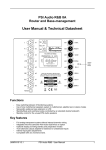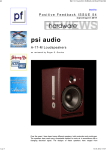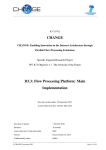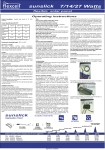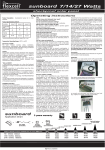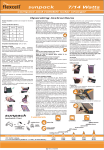Download PSI Audio User Manual
Transcript
PSI Audio User Manual UANPA10 V2.7 PSI Audio User Manual 1 TABLE OF CONTENTS 1 INTRODUCTION................................................................................................................................................. 3 2 SAFETY INSTRUCTION.................................................................................................................................... 3 2.1 2.2 3 WARNINGS ....................................................................................................................................................... 3 SERVICE ........................................................................................................................................................... 4 GENERAL OVERVIEW ..................................................................................................................................... 4 3.1 3.2 3.3 BEFORE YOU START .......................................................................................................................................... 4 FRONT PANEL DESCRIPTION ............................................................................................................................. 5 REAR PANEL DESCRIPTION ............................................................................................................................... 5 4 QUICK START..................................................................................................................................................... 6 5 OPERATION ........................................................................................................................................................ 6 5.1 5.2 5.3 5.4 5.5 5.6 6 INSTALLATION.................................................................................................................................................. 7 6.1 6.2 6.3 6.4 6.5 6.6 6.7 7 POWER ON LED (GREEN)................................................................................................................................ 6 OVERLOAD / OVERHEAT LED (RED)................................................................................................................ 6 AUDIO SIGNAL INPUT CONNECTOR .................................................................................................................. 7 LEVEL / INPUT SENSITIVITY POTENTIOMETER .................................................................................................. 7 ROLL-OFF POTENTIOMETER ............................................................................................................................. 7 VOLTAGE SELECTOR / MAINS FUSE ................................................................................................................. 7 ENVIRONEMENT ............................................................................................................................................... 7 ROLL-OFF SIMPLIFIED THEORETICAL VIEW :..................................................................................................... 7 ROLL-OFF PRACTICAL VIEW : ........................................................................................................................... 7 MOUNTING ....................................................................................................................................................... 9 STEREO OPERATION ......................................................................................................................................... 9 STEREO + SUB OPERATION ............................................................................................................................... 9 MULTI CHANEL 5+1 OPERATION .................................................................................................................... 11 TROUBLESHOOTING ..................................................................................................................................... 12 7.1 7.2 7.3 7.4 POWER ON LED DOES NOT LIT. ...................................................................................................................... 12 UNBALANCED TO BALANCED OPERATION ....................................................................................................... 12 POOR AUDIO QUALITY .................................................................................................................................... 12 UNEVEN FREQUENCY RESPONSE ..................................................................................................................... 12 8 C.E.CONFORMITY........................................................................................................................................... 12 9 WARRANTY ...................................................................................................................................................... 12 UANPA10 V2.7 PSI Audio User Manual 2 1 Introduction Thank you very much, and congratulations on your decision to purchase a professional monitoring system from PSI Audio. Following carefully the instructions in this manual will ensure that your loudspeaker system will give you many years of reliable and trouble free operation. For the latest information, help or advice, please contact your local PSI Audio representative or PSI Audio directly. Relec S.A. ZI Petits Champs 11 a+b CH-1400 YVERDON (Switzerland) Tel : +41 (0)24 426 0420 Tel : +41 (0)24 426 0451 E [email protected] W www.psiaudio.com 2 Safety Instruction This symbol alerts the user to the presence of electrical power within the product that may be of sufficient magnitude to constitute a risk of electric shock. This symbol alerts the user to important operating and maintenance (servicing) instructions or warnings. 2.1 Warnings • Please read and follow the instructions of this manual carefully prior to operation of the loudspeaker. • Please do not open the loudspeaker - risk of electric shock inside. • Make sure not to expose the loudspeaker to any form of liquids. For cleaning purposes use only a dry cloth. In order to prevent spills, do not place any containers containing liquid on the loudspeaker. Do not use the speaker close to water as this may create a shock hazard. • Only use three wire mains cables and connectors with earthling (grounding) according to your country standard. • Check your AC voltage and make sure that the voltage setting and fuse on the rear of the chassis are set correctly. • Do not operate the speaker in a confined environment (i.e. in a flight case) The rear panel of the speaker should be open and permit appropriate circulation and ventilation of air for cooling purposes. Make sure all ventilation openings are free of any obstacles. UANPA10 V2.7 PSI Audio User Manual 3 • Do not operate or install this speaker near any kind of heat source. • Only operate this speaker with accessories specified by PSI Audio. • For maximum operating safety, the loudspeaker should be used with a three-wire AC power system. Two-wire operation may cause a potential hazard. 2.2 Service The loudspeaker contains no user-serviceable parts. All service must be performed by qualified personnel. The primary fuse must be replaced by exactly the same type and rating. The unit must not be opened by the user – risk of a severe electric shock. Servicing is required when : • the speaker has been damaged in some way, such as when the power-supply cord or plug is damaged. • the loudspeaker has suffered from exposure to rain or moisture • liquid has spilled into the loudspeaker. • objects have been dropped into the loudspeaker • the loudspeaker does not work correctly. Spare part supply : • For ordering, please contact your authorized dealer, mentioning your loudspeaker model and serial number (see point 3.3.). 3 General Overview 3.1 Before you start Special care have been taken in the packaging of your PSI Audio equipment. Before you start to install it, please check that the following parts are included : • • • • • Loudspeaker Individual frequency response diagram Data sheet PSI AUDIO User Manual (this manual) Additional stickers according to model UANPA10 V2.7 PSI Audio User Manual 4 3.2 Front Panel Description Power ON LED (Green) Mains power is present and the speaker is ready to use. Overload / Overheat LED (Red) according to model Flashing of the led indicates that the internal limiter is working. If the LED works continuously, the amplifier is operating under overheat conditions. (for Master series : same behavior, but only one LED that also turns red when the speaker is in standby mode) Suggestion for additional logo placement Anti-slide stickers to be placed underneath the unit. 3.3 Rear Panel Description Audio Signal Input Connector INPUT Female XLR with the following wiring convention : 1 = Chassis (Ground) 2 = + Hot 3 = - Cold Model : Serial : LEVEL ROLL OFF RISK OF ELECTRIC SHOCK DO NOT OPEN RISQUE DE CHOC ELECTRIQUE NE PAS OUVRIR GEFAHRC : ELEKTRISCHER AU TIONSCHLAG NICHT ÖFFNEN PSI Audio XX/X N° XXXXXX Roll-Off Potentiometer Aligns the low frequency response to room conditions. Level / Input Sensitivity Potentiometer Audio input signal calibration POWER Power On / Off Switch Voltage Selector / Mains Fuse Selects AC voltage and fuse value UANPA10 V2.7 PSI Audio User Manual 5 4 Quick Start We recommend that you spend some time to set up your monitoring speaker system. Setting it up naturally takes a certain amount of time. However, in case you need to get started quickly, please follow the quick set up guide. The rest of this manual will assist you in setting up your loudspeaker system and calibrate it according to your listening environment. • Check that the voltage value on the AC power selector is set correctly (according to your local AC power supply). If this is not the case, it will be necessary to adjust main power with the following procedure. Carefully squeeze the two latches on either side of the fuse plug and pull the fuse holder out of its socket. Now replace the fuse for the different voltage setting with the correct value fuse according to the required voltage. The correct value of the fuse is printed next to the On-Off switch of your loudspeaker. Pull out the grey plastic cap which holds the fuse and turn it 180° so it shows the correct voltage setting through the outer window when placed back in its position. Now you can carefully push the complete fuse holder back in to its place above the mains connector. • Connect the mains cable with power whilst paying attention to the warnings mentioned under the chapter safety instructions. • Verify that no audio signal is been sent to the loudspeaker and turn the power switch to ON. The green led on the front panel will now illuminate. • Connect the audio source (line signal) from your mixer, preamplifier or other equipment to the XLR connector at the rear. • Turn the Level (input sensitivity) potentiometer fully clockwise. • Verify that the Roll-Off potentiometer is turned fully clockwise in order to provide a flat frequency response to start with. • Set the loudspeaker level potentiometer to the CAL position (CALIBRATED) and fade up the signal source as required. • Normal operating conditions will cause the red led to flash occasionally on peaks. We draw your attention to the fact that this loudspeaker can produce pressure levels which may be harmful. PSI Audio declines all responsibility for eventual hearing loss caused by the use of their loudspeakers. 5 Operation 5.1 Power ON LED (Green) The green LED on the front panel shows that the loudspeaker is powered up. In the event that this LED does not illuminate, verify that the loudspeaker is connected to the AC power outlet and/or check the fuse. 5.2 Overload / Overheat LED (Red) The red LED indicates the operation of the internal limiter and during normal operation, the light flashes when the modulation peak is reaching more than 1 dB level. If the LED flashes regularly, this means that you are reaching overload conditions and you should reduce the input level. If the LED stays continuously illuminated, this means that the amplifier is in overheat conditions, and the components are in risk of damage. Turn off the AC power immediately. Typical causes of overheat are lack of ventilation. Check that sufficient air flow is available around your loudspeaker. Close proximity of overheated sources may also cause overheating. (for Master series : same behavior, but only one LED that also turns red when the speaker is in standby mode) UANPA10 V2.7 PSI Audio User Manual 6 5.3 Audio Signal Input Connector The female XLR connector on the rear panel provides a balanced analogue input with the following wiring conventions : 1 = Chassis (Ground) 2 = + Hot 3 = - Cold When using the loudspeaker with unbalanced sources, the following wiring conventions may be used XLR Cable 1 2 3 Shield/Screen RCA/ Chinch 5.4 Level / Input Sensitivity Potentiometer The level is continuously variable, the potentiometer controls the gain of a converter whose precision is greater than 1 dB. 5.5 Roll-Off Potentiometer See installation section 6 5.6 Voltage Selector / Mains Fuse Cooling space : always make sure that sufficient air flow is available around your loudspeaker to prevent overheating. See point 1 in the Quick Start section 4. 6 Installation 6.1 Environment PSI Audio loudspeakers are calibrated to give flat response under free field conditions. The acoustic environment will naturally influence the overall performances of the loudspeakers. When using the loudspeaker in the studio environment, the Roll-Off control allows the low frequency response to be tailored according to the position of the loudspeaker. Placing a speaker in a corner or near a wall will affect the bass response and this can be compensated by use of the calibration control. 6.2 Roll-Off simplified theoretical view : If a sound source is omni-directional and incorporated into a wall, it radiates into a half space. The generated acoustic pressure is doubled (+ 6 dB) in comparison to free field radiation. For high frequencies, the wavelengths are shorter than the enclosure. Therefore, the enclosure determinates the radiation space. For low frequencies, the wavelengths being longer than the enclosure, it is the positioning and the material of room partitions which determinates the radiation space. When a loudspeaker is not used in free field mode, the « Roll Off » calibration must be applied. 6.3 Roll-Off practical view : Even in very low frequencies, a monitor is not really omni-directional, and it cannot be completely incorporated into a partition. Consequently, the acoustic pressure level will not be entirely doubled by the partition. UANPA10 V2.7 PSI Audio User Manual 7 Roll Off Calibration Simplified theory Practical adjustment Full space (free standing) 0 dB Cal Figure 1 Half space (wall mounting) -6 dB ∼ - 4 dB Figure 2 Quart space (corner mounting) -12 dB ∼ - 7 dB Figure 3 Fig 1 – Full space : Roll off @ cal. Point Fig 2 – Half-space : Roll off @ ~ - 4dB Fig 3 – Quart-space : Roll off @ ~ - 7dB UANPA10 V2.7 PSI Audio User Manual 8 6.4 Mounting • Vertical • Horizontal Unscrew the medium/high section panel and turn it to 90 degrees.(as shown below) 6.5 Stereo Operation The recommended positioning of loudspeaker anathema is an equilateral triangle of 60 degrees, i.e. the distance of the listener from the loudspeakers will be determined by the distance between the loudspeaker. The high frequency section should be at ear height or slightly higher. This is valid for any music listening mode (stereo, multichanel, etc..). 6.6 Stereo + Sub Operation For music listening, the role of subwoofer is to extend the low frequency response and the maximum sound pressure level in a linear fashion. The placement of a subwoofer, especially in a small control room, can be critical. It is recommended that the user takes some time to find the optimum position. Calibration procedure The monitor Roll Off is positioned at –10dB. The subwoofer is placed on the floor. The distance from the subwoofer to the listener is equal to the distance from the monitor to the listener (± 0.5m). Because of its complementary response, the largest part of very low frequencies are spread by the subwoofer. • Subwoofer level calibration: The first monitor is temporarily positioned in free standing, and the signal is directly applied. Level : Cal Roll Off : Cal The second monitor and the subwoofer are placed at their normal positions, and the signal is applied through the subwoofer. Level : Cal Roll Off : -10dB Signal : 70 @ 150 Hz (i.e. cello low note) UANPA10 V2.7 PSI Audio User Manual 9 • When commuting the first direct monitor or the second together with the subwoofer, the sound level hearing comparison allows a reliable and objective adjustment (± 0.5 dB). When adjusting the subwoofer level, the two systems should provide the same sound impression. Stereo & sub system calibration • The sub level being now calibrated, the signal from the first monitor should go through the sub and its Roll-Off adjusted @ -10dB Stereo & sub system in practice UANPA10 V2.7 PSI Audio User Manual 10 6.7 Multi chanel 5+1 Operation Installation in multichanel covers a wide field of applications and different requirements have their own criteria. • Music & Home Cinema playback C+SUB R L 30° 30° 0° 11 LS RS 5+1 for music: Acoustical center Angle Height C L,R LS,RS SUB 0° ±30° ±100-120° ±10° 1.2m 1.2m ≥1.2m 0m Optimum subwoofer performance may be obtained by the use of two subwoofers • AV Applications (film & video) The standard Left / Right angle for film and TV is 45°. If your loudspeakers have to be installed behind a perforated screen, a 45° angle positioning will give the best results. For sound for picture applications, you may also consider a surround array of 4 (or more) surround speakers. Recommended calibration levels are the following : Left/right/Center : 75 dBC per channel Surround Speaker : 72 dBC each Subwoofer : for film mixing, the subwoofer level has an extra 10dB of headroom. This means that the subwoofer level should be calibrated accordingly i.e. 85 dB in band. UANPA10 V2.7 PSI Audio User Manual 11 7 Troubleshooting 7.1 Power on LED does not lit. Please check that the power switch is set on the ON position and that the mains cable is properly connected to the mains. If the problem persists, check the fuse, the voltage selector and the AC power voltage. If this still not solve the problem, contact PSI Audio or a PSI Audio authorised dealer. 7.2 Unbalanced to balanced operation It can give rise to problems and special care should be taken in wiring. 7.3 Poor audio quality Check the audio cabling to the speaker from the audio source, for poor wiring or broken connection. 7.4 Uneven frequency response In the case of uneven frequency response, please check the performance of the loudspeaker with a known reference source (i.e. your favourite CD). Loss of low frequencies • Wrong phase or wiring • Incorrect “Roll Off” calibration • Wrong positioning in the room. If performance still do not meet with your expectations, please consult the section dealing with installation and calibration of your loudspeaker system to the acoustic environment. 8 C.E.Conformity Beyond the tests of all components, the PSI Audio products have been tested and calibrated according to the highest quality standards An individual frequency response diagram is provided with each loudspeaker. The PSI Audio products have been tested according to EU directives and amendments : Low voltage (LVD), 73/23/EEC + 93/68/EEC, Electromagnetic compatibility (EMC), 89/336/EEC + 92/31/EEC + 93/68/EEC The relevant standards are : EN 60065: 1998, Audio, Video and similar electronic apparatus – Safety requirements (Class I) EN 55103-11996, Product family standard for audio, video, audio-visual and entertainment lighting control apparatus for professional use. Part 1 Emission. EN 55103-2: 1996, Product family standard for audio, video, audio-visual and entertainment lighting control apparatus for professional use. Part 2 : Immunity. 9 Warranty Our products are guaranteed during 2 years against any manufacture default. Fair or wrong wear and tear are not covered by the warranty. We kindly remind the user that unauthorised servicing can void the warranty. For servicing, the expenses and the risks of transport are the responsibility of the customer. For any other provision, the code of the Swiss obligations, Articles 197 to 210 will apply. For any legal action, reference will apply to the Court of Yverdon (Switzerland) only. UANPA10 V2.7 PSI Audio User Manual 12














